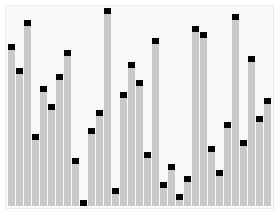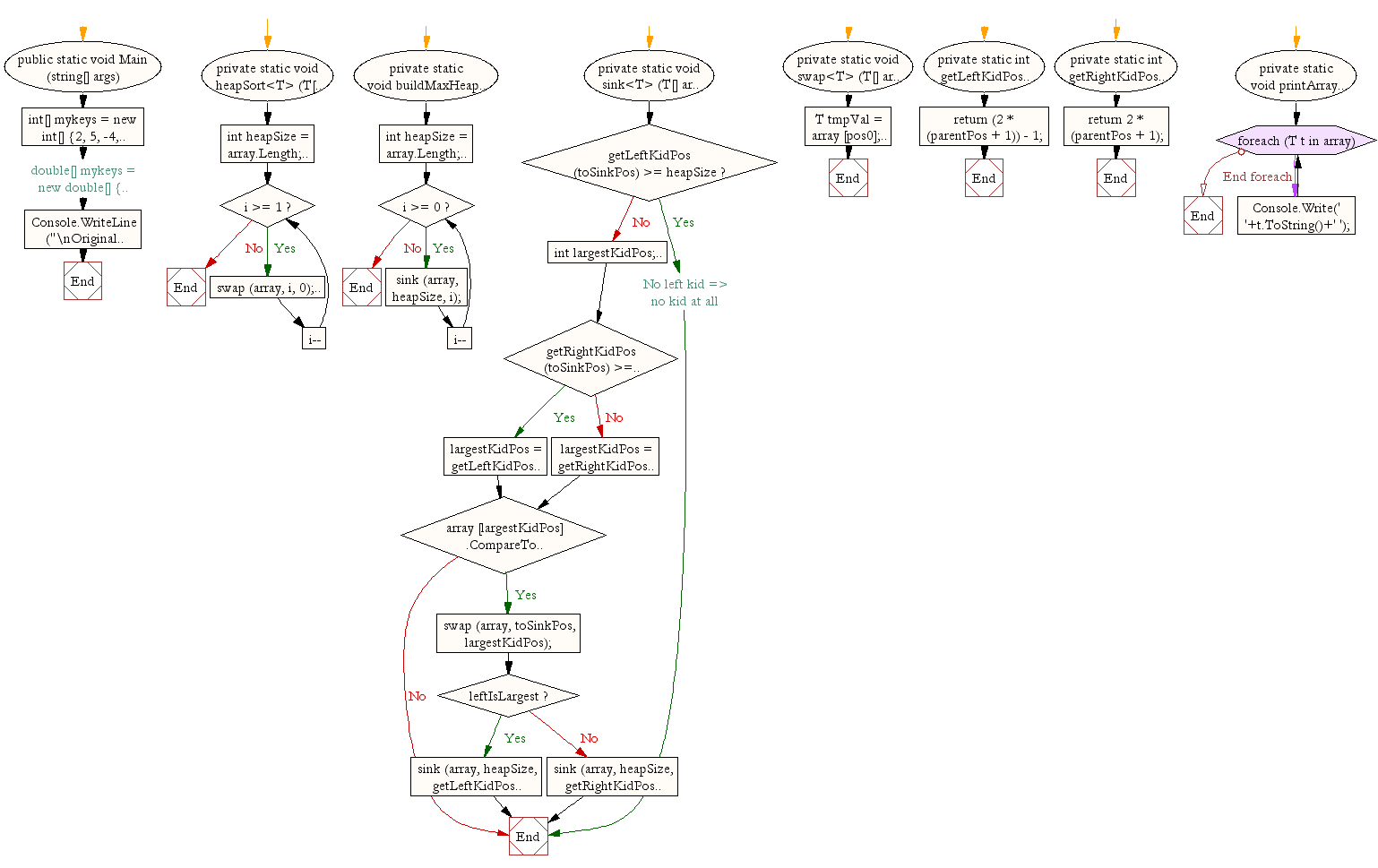C#: Heap sort
Write a C# Sharp program to sort a list of elements using Heap sort.
In computer science, heapsort (invented by J. W. J. Williams in 1964) is a comparison-based sorting algorithm. Heapsort can be thought of as an improved selection sort: like that algorithm, it divides its input into a sorted and an unsorted region, and it interactively shrinks the unsorted region by extracting the largest element and moving that to the sorted region. The improvement consists of the use of a heap data structure rather than a linear-time search to find the maximum. Although somewhat slower in practice on most machines than a well-implemented quicksort, it has the advantage of a more favorable worst-case O(n log n) runtime. Heapsort is an in-place algorithm, but it is not a stable sort.
A run of the heapsort algorithm sorting an array of randomly permuted values. In the first stage of the algorithm the array elements are reordered to satisfy the heap property. Before the actual sorting takes place, the heap tree structure is shown briefly for illustration.

Animation credits : RolandH
Sample Solution:-
C# Sharp Code:
using System;
namespace Heap_sort
{
public class MainClass
{
public static void Main(string[] args)
{
int[] mykeys = new int[] { 2, 5, -4, 11, 0, 18, 22, 67, 51, 6 };
// Uncomment and use the following array types for testing:
// double[] mykeys = new double[] {2.22, 0.5, 2.7, -1.0, 11.2};
// string[] mykeys = new string[] {"Red", "White", "Black", "Green", "Orange"};
Console.WriteLine("\nOriginal Array Elements :");
printArray(mykeys); // Display the original array elements
heapSort(mykeys); // Sort the array using Heap Sort
Console.WriteLine("\n\nSorted Array Elements :");
printArray(mykeys); // Display the sorted array elements
Console.WriteLine("\n");
}
// Method to perform Heap Sort on an array of type T, which implements IComparable
private static void heapSort<T>(T[] array) where T : IComparable<T>
{
int heapSize = array.Length;
buildMaxHeap(array); // Build the max heap
// Sorting by extracting elements from the heap
for (int i = heapSize - 1; i >= 1; i--)
{
swap(array, i, 0); // Swap the first and last elements
heapSize--;
sink(array, heapSize, 0); // Restore the heap property
}
}
// Method to build the max heap
private static void buildMaxHeap<T>(T[] array) where T : IComparable<T>
{
int heapSize = array.Length;
// Iterate over half the array elements and sink each one
for (int i = (heapSize / 2) - 1; i >= 0; i--)
{
sink(array, heapSize, i); // Sink the element to maintain the heap property
}
}
// Method to maintain the heap property
private static void sink<T>(T[] array, int heapSize, int toSinkPos) where T : IComparable<T>
{
if (getLeftKidPos(toSinkPos) >= heapSize)
{
// No left kid => no kid at all
return;
}
int largestKidPos;
bool leftIsLargest;
// Determine the largest kid
if (getRightKidPos(toSinkPos) >= heapSize || array[getRightKidPos(toSinkPos)].CompareTo(array[getLeftKidPos(toSinkPos)]) < 0)
{
largestKidPos = getLeftKidPos(toSinkPos);
leftIsLargest = true;
}
else
{
largestKidPos = getRightKidPos(toSinkPos);
leftIsLargest = false;
}
// Swap the elements if necessary and sink recursively
if (array[largestKidPos].CompareTo(array[toSinkPos]) > 0)
{
swap(array, toSinkPos, largestKidPos);
if (leftIsLargest)
{
sink(array, heapSize, getLeftKidPos(toSinkPos));
}
else
{
sink(array, heapSize, getRightKidPos(toSinkPos));
}
}
}
// Method to swap two elements in the array
private static void swap<T>(T[] array, int pos0, int pos1)
{
T tmpVal = array[pos0];
array[pos0] = array[pos1];
array[pos1] = tmpVal;
}
// Method to get the index of the left child of a parent node
private static int getLeftKidPos(int parentPos)
{
return (2 * (parentPos + 1)) - 1;
}
// Method to get the index of the right child of a parent node
private static int getRightKidPos(int parentPos)
{
return 2 * (parentPos + 1);
}
// Method to print the array elements
private static void printArray<T>(T[] array)
{
foreach (T t in array)
{
Console.Write(' ' + t.ToString() + ' ');
}
}
}
}
Sample Output:
Original Array Elements :
2 5 -4 11 0 18 22 67 51 6
Sorted Array Elements :
-4 0 2 5 6 11 18 22 51 67
Flowchart:

Go to:
PREV : Write a C# Sharp program to sort a list of elements using Counting sort
NEXT :
Write a C# Sharp program to sort a list of elements using Insertion sort.
C# Sharp Practice online:
Contribute your code and comments through Disqus.
What is the difficulty level of this exercise?
Test your Programming skills with w3resource's quiz.
